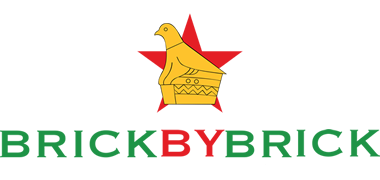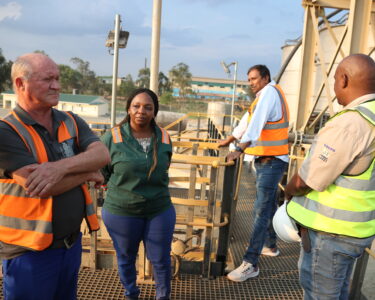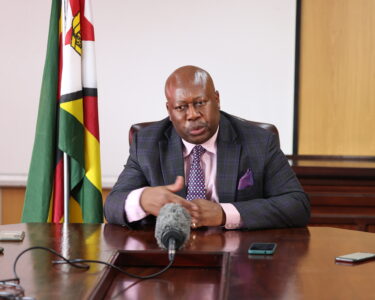If there is anyone out there who doubts that Zimbabwe is on an unstoppable growth trajectory that will soon send tremors across, not only Africa but the world over, that person should visit the multi-billion dollar Dinson Iron and Steel Project in Manhize, Chirumhanzu District. Just the monstrous equipment being installed at the site is enough to tell the story of project that is set to transform Zimbabwe into one of the world’s biggest players in the iron and steel industry.
As the site manager at Dinson Iron and Steel Company (Disco), Johnson Bai, recently told our Editor-in-Chief Munyaradzi Huni, the Manhize project will not only catapult Zimbabwe into the steelmaking champions’ league, but will also see the sprouting of a smart city double the size of Redcliff Town in the Midlands Province. “We are planning to call it Manhize Steel Town,” says Johnson with the confidence of a man absolutely sure of what he is talking about. This humongous project will blow people’s minds.
Seated behind the desk in his makeshift office, Johnson looks calm and composed. His demeanour belies the hive of activity going on outside his office. Even when Disco’s public relations manager, Joseph Shoko, walks in and takes his seat in the same office, he looks at ease as if he is oblivious of the hubbub outside the office.
The two have every reason to look so reticent. If you are leading an iron and steel project that is sitting on 20 to 30 billion tonnes of iron ore resources and is set to transform the country’s landscape, you better be chilled.
Johnson is no newcomer to Zimbabwe.
He says: “I first came to Zimbabwe from China in 2012 when we established Afrochine Smelting, which produces ferrochrome in Selous. Within two years, we were the biggest producers of ferrochrome in Zimbabwe, bigger than Zimasco. In 2015 we set up a second company, Dinson Colliery, and within two years, we were the biggest coke producers in the country. Much bigger than Hwange Colliery.”
Just this brief history is enough to show that Disco is not one of those fly-by-night companies. With such a strong footprint in the country, surely the Manhize project, projected to cost about US$4 billion on completion, is set to take the Second Republic’s modernisation and industrialisation agenda to unprecedented levels.
Continues Johnson: “Welcome to Dinson Iron and Steel in Manhize. It’s our third project in Zimbabwe. We belong to a group called Tsingshan Steel Group, one of the biggest steel companies in the world with over 100,000 employees worldwide.
“In Zimbabwe, we embarked on the Dinson Iron and Steel project in July 2021. When we came here, this was just forest and all the changes you see around you have been taking since July 2021. On completion of phase one, we are looking at producing 600 000 tonnes of carbon steel per year. We are quite confident of meeting this target because we have the Manhize Iron Range close by. Boasting 20 to 30 billion tonnes of iron ore resources, it is the largest iron range in Zimbabwe.
“The iron ore grade is rated between 40-55%, which is among the world’s top grades. This is why President Mnangagwa, not to mention the Minister of Mines [and Mining Development], Winston Chitando, are saying we can mine here for over 100 years. The resource is very rich, meaning from about two to three tonnes of ore, you get one tonne of steel. Just imagine 20 billion tonnes of ore? How much steel will that produce?
“This project will be handed over from one generation to the other. From the carbon steel, you can make cars, window and door frames, etc. In brief, carbon steel is the anchor of multiple industries across the world.”
The figures are quite mouthwatering, to say the least! Surely, Zimbabwe cannot and will not remain a developing country for much longer. Manhize is the game-changer.
Already, all critical equipment to complete the first phase of the project, including blast furnace material, are already on site. Completed works include construction of the administration blocks, erection of platforms for blast furnaces, processing infrastructure and clearing of access roads, among other key preliminary stages.
Speaking about the project last year, President Mnangagwa said Zimbabwe will soon roar like a lion. His words are worth repeating here: “The production, usage and consumption of steel products have been widely regarded as an indicator of economic progress and overall sustainable socio-economic progress. Those who imposed sanctions on us are wondering how we are progressing. We shall progress and rise. Zimbabwe is like a lion and it will continue to roar. The roar of a lion instills fear in those who are against us.”
Indeed, the Lion of Chirumhanzu (or is it the Lion of Manhize?) will soon roar and the country’s enemies will shudder and scatter like sherperd-less sheep!
On completion, the Manhize project will encompass mining, processing and beneficiation plants. The project is so vast that it straddles no less than three of the country’s 10 provinces, notably Mashonaland East, Mashonaland West and Manicaland.
Reports say at full throttle, the project will create up to 14,000 upstream and downstream jobs and is expected to cut steel imports by as much as 90%, while also drastically reducing the prices of local steel products. In 2021, Zimbabwe spent more than US$400 million on steel imports after steel giant, Zimbabwe Iron and Steel Company (Ziscosteel), went into slumber in 2008.
Without flinching, Johnson is optimistic that the Manhize project will see Zimbabwe becoming a force to reckon with in the iron and steel industry in global terms.
“In a few years’ time, we are going to be the second largest steel plant in Africa. Currently, South Africa’s ArcelorMittal is the biggest. They produce 1 to 1.5 million tonnes of steel per year. Here at Dinson Iron and Steel, we are planning to produce 3 million tonnes of steel per year on completion. By that time, we will be much bigger than ArcelorMittal and we will be the biggest steel plant in Africa.
“We plan to export our steel products to China, South Africa, Ethiopia, Zambia and other neighbouring countries. We are going to be the biggest steelmaker in Zimbabwe and Africa. Believe me, this is not a pipedream or idle boast. We have the technology and we have the capacity to achieve our targets within the designated timeframes. This is a project for generations.
“We are constructing a bridge and upgrading the road, about 25km from the Harare-Beitbridge Road. The bridge will be about 18 metres high. We are also planning to construct a railway line from here to Mvuma, then all the way to Mozambique. All this is already planned and budgeted for.
“Phase one of this project will cost us US$1 billion. In total, we are looking at an investment of around US$4 billion. As for employment creation, we already have 800 employees working here, the majority of them local. These are pre-production figures. By October 2023, when we expect the first furnace to be commissioned, we should be having about 4,000 people on our payroll.
“In addition, there are plans to build a new industrial town here, twice the size of Redcliff [the bustling town spawned by yesteryear steel giant Ziscosteel]. It will be called Manhize Steel Town. There are going to be numerous downstream benefits from this project, which is going to change people’s lives. This is our vision.”
Indications are that in the next 10 years, Zimbabwe will be in the same league with countries such as Russia, Turkey and Brazil in terms of its steel production.
Tsingshan Holdings, Disco’s parent company, is a global leader in the manufacture of iron and steel products. Of all the countries in the world, why did they settle for Zimbabwe?
Johnson explains: “First, Zimbabwe has a very good working environment. The weather is good. As I have already indicated, I came to Zimbabwe about 10 years ago and I like the people here. The people are friendly and very hardworking. They are also very educated.
“However, the biggest attraction was the top-grade iron ore in abundance here. We want people all over the world to buy quality but affordable steel products from Zimbabwe. Zimbabwe is seeking to grow its economy and it needs a helping hand from a big company like ours to do so.
“In addition, President Mnangagwa has offered our company very favourable business terms to enable us to operate smoothly from here. We got this vast land, about 11 000 hectares, at a very reasonable cost because we want to do massive things in this country.
“We have already engaged the local traditional leadership and all the relevant authorities. Our approach is that before any investment, we go out of our way to ensure that the community is solidly behind us. Our motto is to come up with projects that benefit the totality of our constituency. Already, we are drilling boreholes, upgrading nearby schools and roads and so on. In addition, when it comes to job recruitment first preference is given to locals. As it is, about 70% of our employees here are from the local community.”
Chief Chirimhanzu, under whose jurisdiction the mega project falls, did not hide his joy: “I am happy that the mining project is about to commence. It will unlock the region’s economic potential. I welcome the investor [Disco] and, as chiefs, we will conduct the mandatory traditional rites so that we will enjoy everlasting prosperity.”
Johnson admits that there are some teething problems, but these will not derail the project as a raft of solutions has been put in place.
“Power cuts are our biggest challenge at the moment,” he says. “We do have generators in place for back-up, but that is very costly in the long run. In view of this, government has given us the greenlight to build a powerline from Sherwood, Kwekwe. The powerline will cost us about US$65 million. In addition, we are also going to build two power plants nearby.
“We are also exploring the possibility of setting up solar plants. However, this is something that might not see the light of day because steelmaking consumes a lot of power, which is likely to push up our overheads.
“The other challenge is transport. As a landlocked country, Zimbabwe has no seaport and the nearest port, Beira, is far away. But to get around this challenge, we will be constructing a railway line from Manhize to Mvuma and henceforth to Mozambique.”
The Manhize project is a culmination of the Second Republic’s bold decision to harness the mutually beneficial, comprehensive and strategic relations between Zimbabwe and the People’s Republic of China.
Johnson sums up the smart partnership between the two all-weather friends as follows: “Besides the steel exports, we are also looking at skills transfer. Once the plant is up and running, we want to train Zimbabweans to operate it so that we leave everything in their hands. This is a project for Zimbabweans.
“There are many Zimbabweans who are working in foreign lands. There is no need for that now. They should come back and work for their country. There are many exciting projects taking place in Zimbabwe. Zimbabwe can only be developed by Zimbabweans. The future is very promising.”
All the way from China, Johnson can see what some Zimbabweans, unfortunately, cannot see. It’s sad, but that will not sidetrack Zimbabwe from its noble goal of building the country one step at a time, brick by brick.
Get ready for a flood of value-added “MADE IN ZIMBABWE” iron and steel products!





